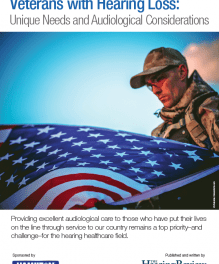Addressing challenges in providing ear and hearing care in low- and middle-income countries
The World Health Organization (WHO) released a new Primary Ear and Hearing Care Training manual on March 3 for World Hearing Day. Organizers of the manual say that it is to assist countries in building the capacity of their health workforce to provide ear and hearing care at the community level.
According to WHO, the manual is a guide on the prevention, identification and management of hearing loss and common ear diseases and can be used to train health workers and clinicians who work at community level primary healthcare facilities. It contains modules on the mechanism of hearing, conducting ear examination and hearing assessment, guidance on prevention, management, and referral of common ear diseases, as well as rehabilitation of hearing loss. The manual also provides hands-on practical activities for skill development.
“Ear and hearing problems are some of the most common conditions encountered in the community,” said WHO Director for the Department for Noncommunicable Diseases, Dr Bente Mikkelsen. “It is critical that these conditions are promptly identified and managed across the continuum of care, starting at primary health care, by training more health workers and doctors so they can provide the needed ear and hearing care services to their communities.”
Reportedly, in most places services for ear and hearing problems remain mainly limited to the tertiary or secondary levels of care, and are provided by highly skilled professionals such as ear, nose and throat (ENT) specialists and audiologists.
Globally, there is a shortage of highly trained ear and hearing care professionals, which is a big challenge towards providing ear and hearing care for all. The majority of low- and middle-income countries have less than one ENT specialist and one audiologist per million population, according to WHO. Meaning that people experiencing hearing difficulties, or those with common ear infections, need to seek specialized care—often at distant hospitals that could lead to undue financial hardships. It also poses an excessive burden on the limited number of ENT specialists and audiologists available in countries.
“Integrating ear and hearing care into primary care will benefit individuals in need of these services,” said Dr Shelly Chadha, technical lead for ear and hearing care at WHO. “It will also help countries to move towards the goal of universal health coverage.”
Equitable access requires a reorientation of the model of care with integration of the required services at the primary level. Healthcare providers such as doctors, nurses, and community health workers should be empowered with the relevant knowledge and skills through systematic training on ear and hearing care, WHO reports.
In addition to the training manual, a trainer’s handbook is included and intended for use by those involved in training health workers or in coordinating programs for delivering ear and hearing care. A set of community resources made up of flyers covering topics such as when to suspect hearing loss in an adult and tips for healthy ears and safe listening are also available in the 6 UN languages.
Source: WHO
Images: Photo 52861766 © Monkey Business Images | Dreamstime.com





